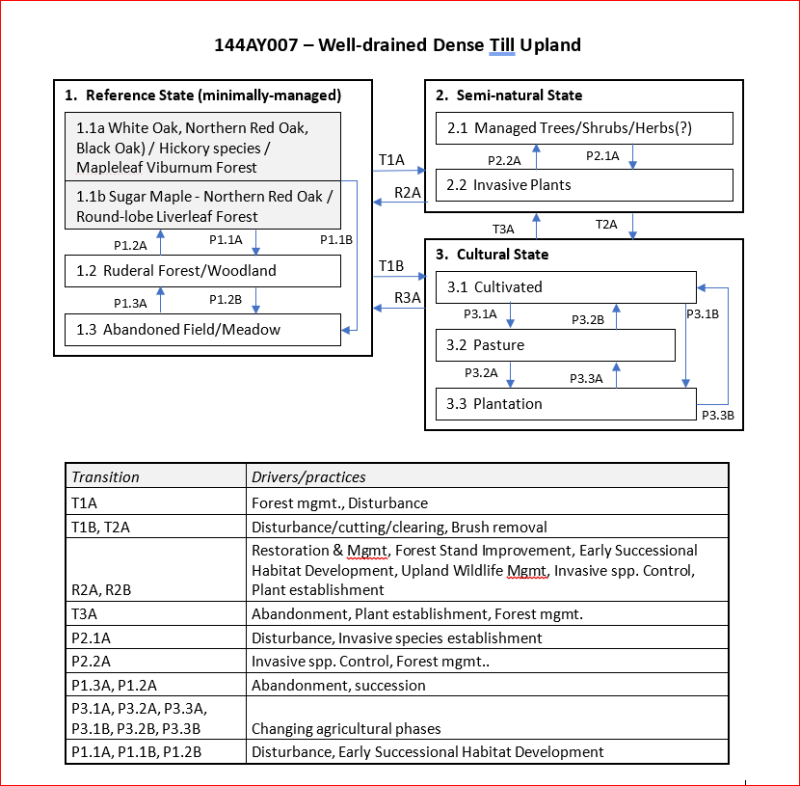
Natural Resources
Conservation Service
Ecological site F144AY007CT
Well Drained Dense Till Uplands
Last updated: 10/03/2024
Accessed: 12/21/2025
General information
Provisional. A provisional ecological site description has undergone quality control and quality assurance review. It contains a working state and transition model and enough information to identify the ecological site.
MLRA notes
Major Land Resource Area (MLRA): 144A–New England and Eastern New York Upland, Southern Part
The eastern half of the eastern part of this MLRA is in the Seaboard Lowland Section of the New England Province of the Appalachian Highlands. The western half of the eastern part and the southeastern half of the western part are in the New England Upland Section of the same province and division. The northwestern half of the western part is in the Hudson Valley Section of the Valley and Ridge Province of the Appalachian Highlands. This MLRA is a very scenic area of rolling to hilly uplands that are broken by many gently sloping to level valleys that terminate in coastal lowlands. Elevation ranges from sea level to 1,000 feet in much of the area, but it is 2,000 feet on some hills. Relief is mostly about 6 to 65 feet in the valleys and about 80 to 330 feet in the uplands.
This area has been glaciated and consists almost entirely of till hills, drumlins, and bedrock-controlled uplands with a mantle of till. It is dissected by narrow glacio-fluvial valleys. The southernmost boundary of the area marks the farthest southward extent of Wisconsinian glaciation on the eastern seaboard. The river valleys and coastal plains are filled with glacial lake sediments, marine sediments, and glacial outwash. The bedrock in the eastern half of the area consists primarily of igneous and metamorphic rocks of early Paleozoic age. Granite is the most common igneous rock, and gneiss, schist, and slate are the most common metamorphic rocks. In the parts of the MLRA in eastern and southeastern New York, Devonian- to Pennsylvanian-age sandstone, shale, and limestone are dominant. Carbonate rocks, primarily dolomite and limestone, are the dominant kinds of bedrock in the part of this MLRA in northwestern Connecticut.
Classification relationships
USDA-NRCS (USDA 2006):
Land Resource Region (LRR): N—East and Central Farming and Forest Region
Major Land Resource Area (MLRA): 144A— New England and Eastern New York Upland, Southern Part.
USDA-FS (Cleland et al. 2007)
Province: 221 - Eastern Broadleaf Province
Section: 221A - Lower New England
Subsection: 221Aa – Boston Basin
221Ac – Narragansett-Bristol Lowland and Islands
221Ad – Southern New England Coastal Lowland
221Ae – Hudson Highlands
221Ag - Southeast New England Coastal Hills and Plains
221Ah - Worcester-Monadnock Plateau
221Ai – Gulf of Maine Coastal Plain
221Ak - Gulf of Maine Coastal Lowland
Section: 221B – Hudson Valley
Subsection: 221Ba – Hudson Limestone Valley
221Bb - Miami – Taconic Foothills
221Bc – Hudson Glacial Lake Plains
Ecological site concept
The Well-Drained Dense Till Uplands ecological site consists of well drained, loamy soils formed in basal till derived mostly from gneiss, schist, and granite. The soils are very deep to bedrock and moderately deep to a densic contact. They are nearly level through steep soils on till plains, hills, and drumlins. Representative soils are Essex, Newport, Poquonock, Montauk, Paxton, Annisquam, Bernardston, Broadalbin, and Broadbrook.
Representative plant communities are typically dominated by a mixed oak-sugar maple forest. The vegetation is not well described. Dense till sites are considered slightly more mesophytic than ablation till sites, hence contain more sugar maple (Acer saccharum) and white ash (Fraxinus americana).
The site is very similar to the Well Drained Dense Till Uplands within MLRA 145, however the growing season is longer within MLRA 145 relative to the surrounding MLRA 144A. Additionally, the unique red soil mineralogy which characteristic of the Connecticut River Valley (MLRA 145) provides a relatively richer substrate for vegetative growth.
Associated sites
| F144AY033MA |
Shallow Dry Till Uplands |
|---|---|
| F144AY034CT |
Well Drained Till Uplands |
Similar sites
| F144AY008CT |
Moist Till Uplands |
|---|---|
| F144AY018NY |
Moist Lake Plain |
Table 1. Dominant plant species
| Tree |
(1) Quercus rubra |
|---|---|
| Shrub |
(1) Viburnum acerifolium |
| Herbaceous |
(1) Aralia nudicaulis |
Click on box and path labels to scroll to the respective text.
